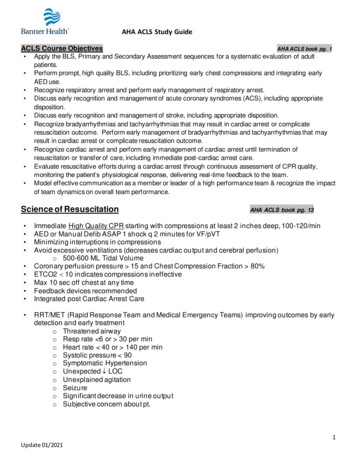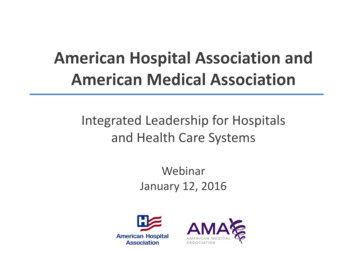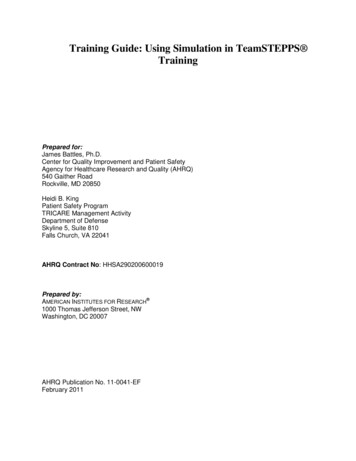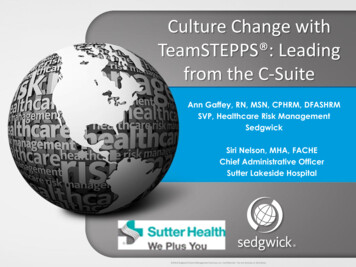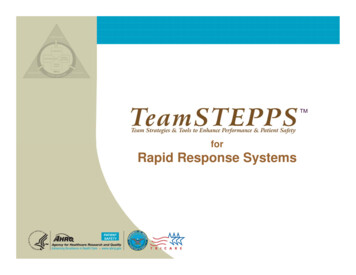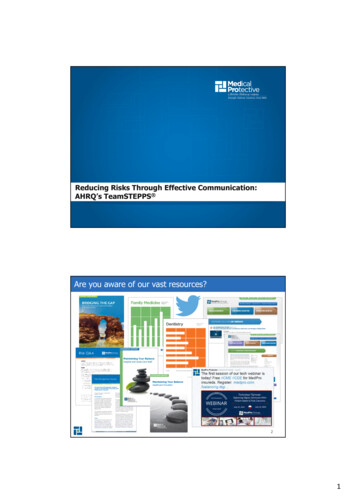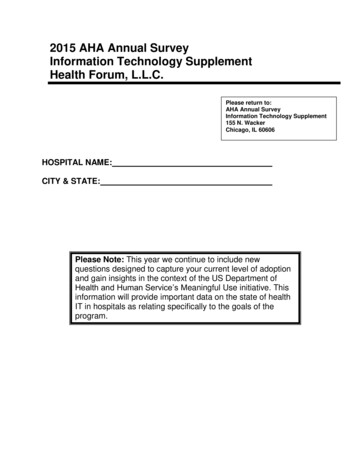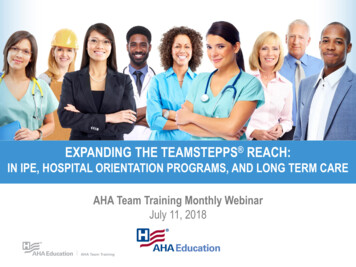
Transcription
EXPANDING THE TEAMSTEPPS REACH:IN IPE, HOSPITAL ORIENTATION PROGRAMS, AND LONG TERM CAREAHA Team Training Monthly WebinarJuly 11, 2018
RULES OF ENGAGEMENT Audio for the webinar can be accessed in two ways: Through the phone (*Please mute your computer speakers) Through your computer A Q&A session will be held at the end of the presentation Written questions are encouraged throughout the presentation and will beanswered during the Q&A session To submit a question, type it into the Chat Area and send it at any timeduring the presentation2
UPCOMING TEAM TRAINING EVENTS Our next free webinar will be August 8 at 12:00 pm CT “From the Cockpit to Your Operating Room: Strategies toEmpower Leaders to Lead” We have spots available in our Master Training Courses: August 13-14 in Seattle, WA with University of Washington September 20-21 in Centennial, CO with University of Washington October 4-5 in Cleveland, OH with MetroHealth November 8-9 in Durham, NC with Duke University Stay tuned for the 2019 AHA Team Training National Conference dateand location!3
CONTACT INFORMATIONWeb: www.aha.org/teamtrainingEmail: TeamTraining@aha.orgPhone: 312-422-26094
TODAY’S PRESENTERSEnter headshothere (ifapplicable)Laura GoliatDNP, RN, FNP-BCAssociate ProfessorThe Breen School of NursingUrsuline CollegePepper Pike, OhioRegina ProsserDNP, RN-BC, CNE, LNHAAssistant ProfessorRN-BSN Program CoordinatorThe Breen School of NursingUrsuline CollegePepper Pike, OhioPatricia A. SharpnackDNP, RN, CNE, NEA-BC, ANEFDean and Strawbridge ProfessorThe Breen School of NursingUrsuline CollegePepper Pike, Ohio
LEARNING OBJECTIVES Summarize the steps involved in delivering an IPE experienceusing the TeamSTEPPS model Discuss strategies for implementation of TeamSTEPPS in LongTerm Care Describe how foundational TeamSTEPPS education can beintegrated into a major health system’s medical-surgicalresidency program6
WEBINAR OVERVIEWExpanding the TeamSTEPPS Reach Integration 1: TeamSTEPPS in IPE Integration 2: TeamSTEPPS in Long Term Care Integration 3: TeamSTEPPS in HospitalOrientation Residency Programs7
INTEGRATION 1:INTERPROFESSIONAL EDUCATION8
NEEDS OF SYSTEMS AND BARRIERS To Err is Human Silos Opportunity Time/Scheduling Leveling Resources9
IPEC COMPETENCIES10
TAILORED PROGRAM11
DELIVERY12
MEASURES13
LESSONS LEARNED14
INTEGRATION 2:LONG TERM CARE Needs of the system and unique barriers Collaboration Competencies Audience Tools and strategies15
NEEDS OF SYSTEMS AND BARRIERS Environment (RN’s, LPNs, nursing assistant,social work, dietician, pharmacist, etc.) Staffing (type, ratio, turnover) Resources Physical presence of team members Reporting structure (rounding, shift overlap) Communication (respect, trust) Effective teams16
THE TIME IS NOW F940 §483.95 Training Requirements F941 §483.95(a) Communication. A facility must includeeffective communications as mandatory training fordirect care staff. [§483.95(a) will be implementedbeginning November 28, 2019 (Phase 3)]17
COLLABORATION Partners in education Past relationships Professional organizations Dual quality improvement projects18
STRATEGIES Team Structure and roles I-SBARR CUS Two-Challenge19
DELIVERY Case scenarios Small group exercises (mix them up!) Location of training Class size Administrative support20
AUDIENCE Administration Department directors Unit staff (nursing, staff support, social worker,dietician, maintenance, dietary worker,housekeeping, activities) MDS nurses21
LESSONS LEARNED Access to learning Resources Time management Sustainability Working in silos Pre training discussion – what is neededmost?22
INTEGRATION 3:TEAMSTEPPS IN HOSPITAL ORIENTATIONRESIDENCY PROGRAMS Collaborative Meetings: Academia meets PracticeNeeds of System and BarriersTailored ProgramDeliveryMeasuresThis Photo by Unknown Author is licensed under CC BY-SA23
COLLABORATION HISTORY Northeast Ohio Action Coalition Education and practice leadership Gap analysis Shared mental model - Patient safety24
NEEDS OF SYSTEMS AND BARRIERS Critical thinking Communication I-SBARR Team building (retention) Confidence toward advocacy Space, schedule, faculty trainers, IT support,materialsThis Photo by Unknown Author is licensed under CC BY-SA25
TAILORED PROGRAM OBJECTIVES Recognize the importance of developingeffective teams for the provision of highquality and safe patient care Understand the five constructs essentialfor achieving high-functioning teams asdefined by the TeamSTEPPS program Gain knowledge of the TeamSTEPPS ISBARR tool Develop effective I-SBARR responsesto videotaped clinical scenarios26
DELIVERY Seven (7) sessions 8:30am – 11:45pmMondays Core TeamSTEPPSMaster Trainers Instructor #1 & #2(consistency) Off-site location Team Structure,Leadership,Communication,Situation Monitoring,Mutual Support,Pulling It All Together27
MEASURES Pre-intervention Data Collection (written I-SBARRbased on video scenario simulation) Program evaluation Post intervention ( 2 weeks) Post intervention (3 and 6 months) Post intervention (7 months)28
LESSONS LEARNED Technology doesn’t always work – have aPlan B I-SBARR most difficult skill Favorable feedback3. I have an increased understanding of theTeamSTEPPS constructs, tools, andstrategies as a result of this program4. This program facilitated my ability to usethe I-SBARR communication tool moreeffectively29
CONTACT INFORMATIONThank you!Laura Goliatlgoliat@ursuline.eduRegina Prosserrprosser@ursuline.eduPatricia Sharpnackpsharpnack@ursuline.edu30
QUESTIONS? Stay in touch! Email teamtraining@aha.org or visitwww.aha.org/teamtraining31
DNP, RN, CNE, NEA-BC, ANEF Dean and Strawbridge Professor The Breen School of Nursing Ursuline College Pepper Pike, Ohio Enter headshot here (if applicable) Laura Goliat DNP, RN, FNP -BC Associate Professor Pepper Pike, Ohio Regina Prosser DNP, RN BC, CNE, LNHA Assistant Professor RN-BSN Program Coordinator The Breen School of Nursing Ursuline .



